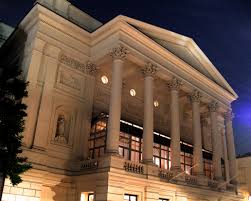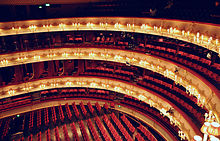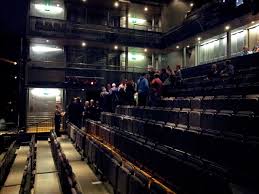Difference between revisions of "Royal Opera House"
From Londonhua WIKI
Mthatfalvi (talk | contribs) |
Mthatfalvi (talk | contribs) |
||
| Line 23: | Line 23: | ||
__TOC__ | __TOC__ | ||
<br> | <br> | ||
| + | =History= | ||
| + | <br><br> | ||
=Theater Space= | =Theater Space= | ||
==Main Stage== | ==Main Stage== | ||
Revision as of 13:20, 20 May 2017
Royal Opera House
Overview
After the British Civil War, only two theaters were instated for 28 years. Those theaters were the Drury Theater and the Royal Opera House. The Opera House burned down twice before the current building was built. Two years ago the Royal Opera House doubled its size and renovated the existing parts of the building. The total cost was over £200 million. The Royal Opera House now has two proscenium theaters and eight dance studios. There are also two sister dance schools that are considered amongst the most prestigious in the world next to France and Moscow.
Contents
History
Theater Space
Main Stage
The original auditorium is used as the main theater. It has over 2,500 seats. The main stage is proscenium style with no apron. The stage is 15 meters square. The orchestra pit can fit 90-109 musicians. The floor of the pit is hydraulic and has three heights. The top level is used for concerts. The second level is used for smaller orchestra shows. The third and lowest level of the pit is used for large orchestra shows. This enables more musicians to fit in the pit and for dampening of the sound so the performers can be better heard. While it was recently redone, the auditorium retains its original renaissance style. It even still has a box for the royal family that was first created for Queen Elizabeth I. There is also an adjoining room for the royal family to eat and wait in before the show.
Linbury Studio
The Linbury Studio is the secondary theater used for smaller and experimental shows. It seats 400 guests. This stage is also in the proscenium style.
Scenic
The Royal Opera House makes all of its own sets off-site in Thurrock. There the sets are fabricated, deconstructed and sent to the theater. Upon arrival at the theater, the tractor trailer holding the pallets filled with the set backs into a massive elevator. This elevator then brings the truck to the unloading bay where the pallets are stored on a conveyor system. This system is then integrated with the wagon system that Rolls Royce designed for the theater. The wagon system allows for extremely fast set changes between shows, only 20 minutes. The stage floor rests on three wagons with the rest of the set on top. The stage has a hydraulic floor system. To switch between shows, the current floor can be raised and transported out of the way allowing the new floor to slide and be lowered into place. That process takes only 40 seconds. The Royal Opera House is one of only two theaters to have this system.
Props
The Royal Opera House would not be complete to make a show without it's Prop department. This includes of team of artists, sculptors, engineers and welders. Mostly all of the props are made in this department or it is used from warehouse storage. Beautiful props complete the performances and a lot of work goes into each production. Anything can be made and anything can be changed to look like something it isn't. Like plaster, molds, and paint can be made to look like food. [1]
Lighting & Projections
Unlike many theaters, the Royal Opera House has the lighting fixtures located in a panel that can retract from dome of the roof. When the lights are not needed for a show, the panels retract and blend in with the rest of the dome. This concept was to keep the proscenium free from truss and fixtures that would distract the viewer from what was going on. When the renovation was being done on the theater, the ETC lighting company received the contract to provide and setup numerous fixtures, consoles and a house control system. They also have lights on the back stage batons so that the dancers and singers can see on stage.
Sound
When the theater was rebuilt two years ago, the sound designers decided to remove the carpeting from the stair and along the theater seat floor. This was to give the theater better acoustics because the singers or instrumentalists do not use microphones. There is no much in the way of sound as far as sound goes for the operas and ballets.
Costumes
The Royal Opera House makes all of their costumes in house. There are three sub-departments in their costume department. The first is in charge of creating costumes for the first performance of a show. The other two departments are in charge of care, maintenance and organization of the costumes. After the first show, costumes become their responsibility. They take care of laundry and mending any damage to the costumes. After a show has completed its run, costumes are then put into storage off-site until the next run of the show. Properly stored and cared for costumes can last for decades of use.
References
- ↑ Props to you! Prop-making tricks of the trade revealed - Royal Opera House. (n.d.). Retrieved May 20, 2017, from http://www.roh.org.uk/news/props-to-you-prop-making-tricks-of-the-trade-revealed
External Links
If appropriate, add an external links section


